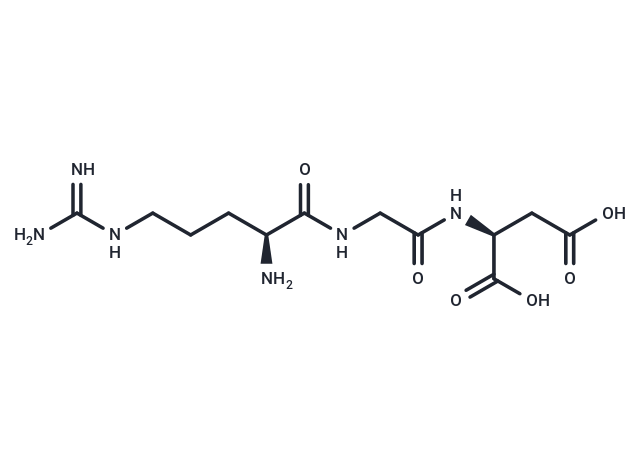Shopping Cart
- Remove All
 Your shopping cart is currently empty
Your shopping cart is currently empty

Arginine-glycine-aspartic acid (RGD) is a cell adhesion motif which can mimic cell adhesion proteins and bind to integrins.

| Pack Size | Price | Availability | Quantity |
|---|---|---|---|
| 2 mg | $34 | In Stock | |
| 5 mg | $54 | In Stock | |
| 10 mg | $97 | In Stock | |
| 25 mg | $155 | In Stock | |
| 50 mg | $279 | In Stock | |
| 100 mg | $437 | In Stock |
| Description | Arginine-glycine-aspartic acid |
| In vitro | The RGD sequence is the cell attachment site of a large number of adhesive extracellular matrix, blood, and cell surface proteins, and nearly half of the over 20 known integrins recognize this sequence in their adhesion protein ligands. The RGD peptides and mimics can be used to probe integrin functions in various biological systems. Drug design based on the RGD structure may provide new treatments for diseases such as thrombosis, osteoporosis, and cancer. [1] RGD peptide acts as an inhibitor of integrin-ligand interactions and can induce apoptosis in the absence of signals and integrin-mediated cell clustering. Research demonstrates that RGD peptides promote apoptosis through activation of conformation changes that enhance pro-caspase-3 activation and autoprocessing. [2] The RGD peptide can serve as a cell adhesion site of extracellular matrix, cell surface proteins, and integrins. [3] In addition, RGD peptide can inhibit ACK-2 activation through cell adhesion. [4] |
| Alias | RGD Peptides, RGD, Arg-Gly-Asp |
| Molecular Weight | 346.34 |
| Formula | C12H22N6O6 |
| Cas No. | 99896-85-2 |
| Smiles | N[C@@H](CCCNC(N)=N)C(=O)NCC(=O)N[C@@H](CC(O)=O)C(O)=O |
| Relative Density. | 1.61 g/cm3 |
| Storage | keep away from moisture | Powder: -20°C for 3 years | In solvent: -80°C for 1 year | Shipping with blue ice. | |||||||||||||||||||||||||
| Solubility Information | H2O: 34.6 mM, Sonication is recommended. | |||||||||||||||||||||||||
Solution Preparation Table | ||||||||||||||||||||||||||
H2O
| ||||||||||||||||||||||||||

Copyright © 2015-2025 TargetMol Chemicals Inc. All Rights Reserved.